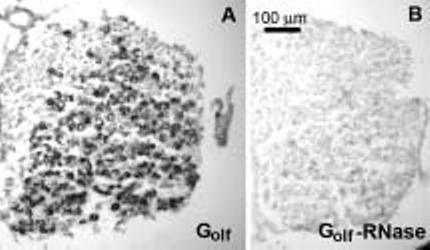Fig. 1.

Localization of Golfalpha in Scarpa's ganglion using in situ hybridization. (A) Photomicrographs illustrating hybridization with digoxigenin labeled Golfalpha cRNA to a 10 μm thick section of Scarpa's ganglion. (B) Hybridization with Golfalpha cRNA after treating the section with RNase. Because of the high sequence homology of the Golfalpha and Gαs mRNA, the hybridization was repeated at a higher stringency condition of 65°C without appreciable loss of signal, further confirming the expression of Golfalpha.
